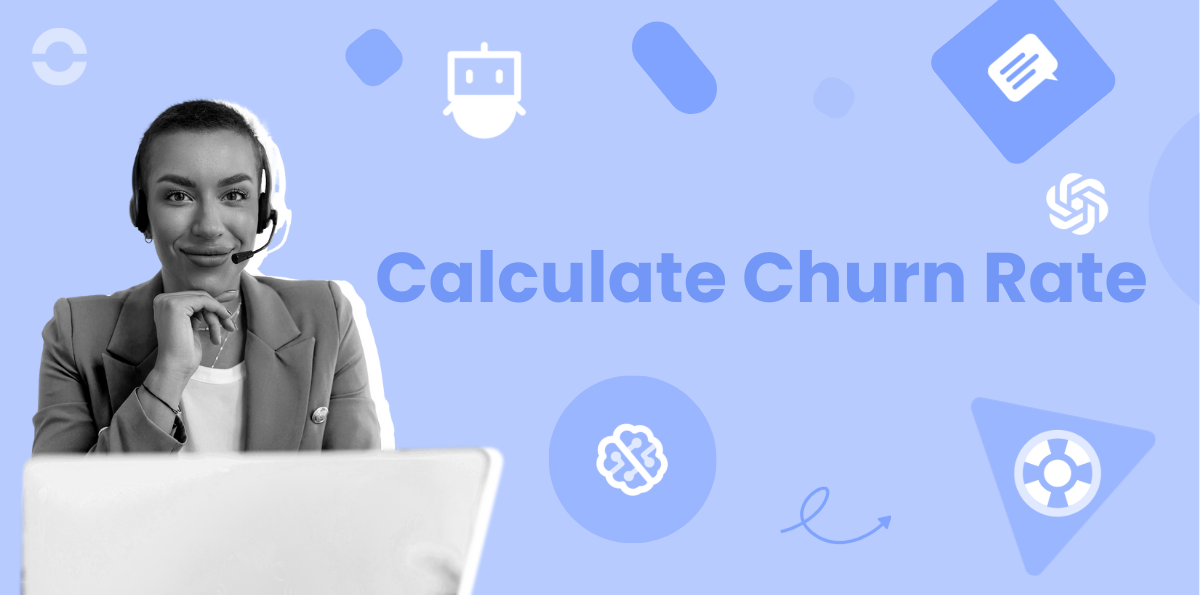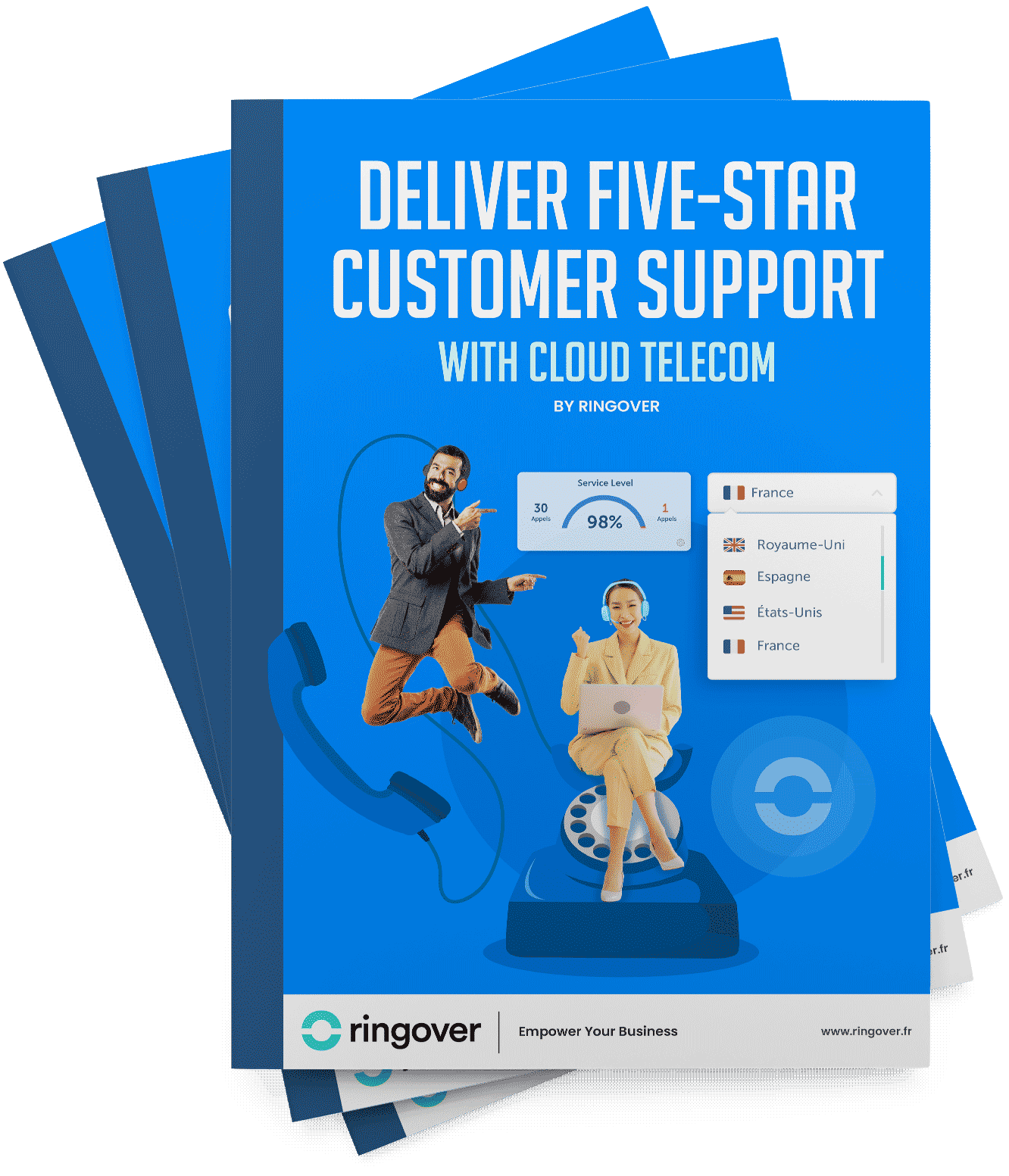Summary
- Definition of the churn rate
- Churn Rate Formula
- How to Calculate Churn Rate (with Numbered Steps)
- How to Reduce Churn? By What Means?
- Why Is Churn Rate Important?
- What's the Difference Between Customer Churn Rate and Revenue Churn Rate?
- How to Calculate Revenue Churn Rate
- Why Do Your Customers Unsubscribe?
- Ringover Can Help You Reduce Your Churn
- Conclusion: Final Thoughts
Tracking churn rate helps you understand how satisfied your customers are with your business. SaaS companies which rely on recurring revenue also get valuable insights into current performance and future revenue by following this metric.
Tracking churn rate helps you understand how satisfied your customers are with your business.
Book a Demo With Ringover Today!Definition of the churn rate
The churn rate is a KPI measuring the loss of customers over time. The churn rate is usually expressed as a percentage and is calculated by dividing the number of customers who unsubscribe or do not renew their subscription by the total number of customers at a given time.
Churn Rate Formula
Churn Rate = (Number of lost customers / Total number of customers) * 100
Let's look at an example. If a SaaS company has 1,000 customers and 100 of them unsubscribe or do not renew their subscription, the churn rate would be (100/1000) * 100 = 10%.
How to Calculate Churn Rate (with Numbered Steps)
1. Define the Time Period
Decide whether you want to calculate churn rate monthly, quarterly, or annually. The period you choose should align with your business goals and reporting schedule.
2. Identify the Number of Customers at the Start
Record how many active customers you had at the beginning of the selected time period. This is your starting customer base.
3. Determine the Number of Lost Customers
Count how many customers stopped using your product or service during the same period. These are your churned customers.
4. Use the Formula
Churn Rate = (Number of Lost Customers / Number of Customers at the Start) × 100
5. Interpret the Results
The churn rate is expressed as a percentage. A lower percentage indicates better customer retention, while a higher rate signals the need for retention strategies.
How to Reduce Churn? By What Means?
Customer retention is closely linked to your growth and profitability. Therefore, it is crucial to reduce churn as much as possible. But how can this be achieved? Here are some effective examples:
- Offer an Exceptional Customer Experience: Ensure that every interaction with your customers is pleasant and attentive. Respond promptly to their needs and concerns, provide quality support, and continuously seek to improve their experience.
- Communicate Regularly with Your Customers: Maintain open and regular communication with your customers. Inform them about new features, updates, and special offers. Show them that you care about their satisfaction.
- Monitor Warning Signs: Identify warning signs that may indicate your customers are about to unsubscribe, such as a decrease in product or service usage or recurring complaints. Act quickly to resolve issues and prevent churn. Solutions like Empower can help you monitor these warning signs by detecting churn-related terms in your customers' conversations.
- Reward Loyalty: Implement loyalty programs or rewards to encourage your customers to stay loyal to your company. Offer special benefits, discounts, or gifts to thank them for their loyalty. If you are in B2B SaaS, invite your VIP clients to attend some of your events, which is often more personal than the classic end-of-year box of chocolates.
- Offer Personalized Solutions: Seek to understand your customers' individual needs and provide personalised solutions. The more your customers feel understood and valued, the less likely they are to unsubscribe.
Why Is Churn Rate Important?
Churn rate is a key indicator of your company's health and customer satisfaction. Here's why it matters:
- Revenue Impact: High churn means lost customers, which directly impacts revenue. A high churn rate can erode any new customer acquisition efforts, making it harder to grow.
- Customer Retention: Understanding churn helps you evaluate your customer retention strategies. By identifying when and why customers leave, you can implement targeted retention programs.
- Business Forecasting: Churn rate allows you to predict future revenue loss and identify trends, helping you make informed decisions about customer acquisition and business growth.
- Customer Experience Insight: High churn rates can indicate dissatisfaction, product issues, or better alternatives in the market. It serves as a signal to improve customer experience and service quality.
What's the Difference Between Customer Churn Rate and Revenue Churn Rate?
There are two primary types of churn: customer churn rate and revenue churn rate. Here's the key distinction.
Customer churn rate measures the percentage of customers who stop doing business with your company over a specific period. It focuses solely on the number of customers lost.
Revenue churn rate calculates the revenue lost due to customer churn. It accounts for the monetary value associated with those lost customers, offering a financial perspective on churn. Revenue churn can also reflect reductions in customer spend (e.g., downgrades) even if the customer has not completely left.
Understanding both metrics is crucial because while customer churn shows how many customers you're losing, revenue churn highlights the financial impact, which could be greater or lesser depending on the value of the lost customers.
How to Calculate Revenue Churn Rate
Revenue churn rate provides insight into how much recurring revenue is being lost from existing customers. Here's how to calculate it:
1. Define the Time Period
Like customer churn, choose a period (monthly, quarterly, or annually) for tracking revenue churn.
2. Identify Revenue at the Start
Record the total recurring revenue at the beginning of the time period.
3. Determine Revenue Lost from Churned Customers
Calculate the revenue lost from customers who cancelled or downgraded their service during the period.
4. Use the Formula
Revenue Churn Rate = (Revenue Lost / Total Revenue at the Start) × 100
5. Interpret the Results
A high revenue churn rate indicates a significant loss in recurring revenue, potentially from high-value customers. This metric helps you understand the financial consequences of churn and whether retention efforts should target higher-paying customers.
Why Do Your Customers Unsubscribe?
It is important to understand why your customers unsubscribe or do not renew their subscription in order to address the underlying issues. Here are some common reasons why customers unsubscribe:
Dissatisfaction with the Product or Service ✅
If your customers are not satisfied with what they receive, they will be more likely to unsubscribe. Make sure to offer a high-quality product or service that meets customer expectations.
Poor Customer Experience ✅
If customers encounter problems while using your product/service, do not receive the necessary support, or do not feel valued, they are less likely to remain loyal to your company. Ensure you provide an exceptional customer experience at every stage of the customer journey and create value.
Lack of Communication ✅
If you do not communicate regularly or effectively with your customers, they may unsubscribe due to a lack of interest or trust. Make sure to keep your customers informed about new developments, updates, and special offers, and be proactive in addressing any issues.
For example, you can create a "Status" webpage accessible from your SaaS product that informs your customers about the status of your service, any potential issues, and the measures you are taking to resolve them.
This proactive approach allows you to alleviate congestion on business phone lines and reduce frustration caused by a lack of communication.
Competition ✅
If your competitors offer similar products or services at a lower price or with additional features, your customers might be tempted to switch providers. Stay informed about what your competitors are doing and strive to remain competitive in the market. The SaaS sector evolves rapidly, and it is essential to stay at the forefront of innovation to avoid falling behind.
Changing Needs or Circumstances ✅
Customer needs can change over time. They might no longer need your product or service or might face circumstances that compel them to unsubscribe. Try to understand the constantly evolving needs of your customers to anticipate their expectations. This highlights the necessity of regular communication, gathering feedback on your service, and listening to their suggestions.
Ringover Can Help You Reduce Your Churn
Ringover can assist you in reducing your churn rate in several ways. First, you can use our eponymous solution and its omnichannel module to provide a seamless experience for your customers during interactions.
Integrating Ringover with your CRM also allows you to refine your communication and offer custom greetings. Indeed, the telephone integration with the CRM enables the automatic display of the customer file when your team members receive an external call, thus showing the contact's CRM file immediately.
This integration also allows access to the history of interactions between the customers and the company, preventing the customer from having to repeat the reason for their call if it gets transferred.
In addition to its business communication solution, Ringover has developed an AI-based conversational intelligence software called Empower. It features advanced transcription and automatic translation capabilities. In other words, each phone conversation is automatically transcribed to provide customer service agents with key insights into their performance and customer interactions.
As mentioned earlier, it is also possible to automatically detect terms that suggest potential churn using a system of customizable tags. For example, you can set Empower to automatically identify terms like “subscription,” “satisfied,” or “dissatisfied” in conversations your customers have with your team members.
Conclusion: Final Thoughts
Reducing the churn rate is crucial to ensuring the sustainability and growth of a business. Understanding the reasons that lead customers to unsubscribe is the first step in implementing effective retention measures.
Factors such as product dissatisfaction, poor customer experience, lack of communication, competition, and changing needs must be closely monitored.
To reduce churn, it is essential to offer an exceptional customer experience, maintain regular communication, monitor warning signs, and reward loyalty.
Ringover offers innovative solutions to help companies reduce their churn rate. Its omnichannel contact centre software, CRM integration (including Salesforce, Hubspot, Zoho, and more), and AI-based Empower software are effective tools for improving customer communication, analysing interactions, and detecting early signs of churn.
By integrating these solutions, companies can not only reduce their churn rate but also strengthen customer loyalty and drive growth.
To learn more about Ringover or Empower, begin your free trials today!



